|
|
||||
| ARTER, COSTANDI, DISPENZA, CASTRAVET GOULD. Heritage Welcome Center |
||||
| [in italiano] |
 The competition site for the Heritage Welcome Center is located four miles South-East from Mammoth Cave National Park, in Park City, Kentucky, at the intersection of Highway 65, Route 255, and Route 31. The Program called for the design of a 45,000-60,000 SF building that would become an important cultural and tourist node, presenting the rich history and heritage of the area through a program consisting of: library, archive, auditorium, museum space, classrooms, gift shop, indoor and outdoor arts and crafts venues. |
[18aug2001] | ||

Floor plans: The museum contains an entry hall with ticket counters, gift shop, and administrative offices on the first floor, auditorium, and library on Level –1, classrooms and archive on Level –2, and museum gallery and atrium on Level –3. Teak lattice screens on each level open up in order to allow the activities from the inside to spill out onto the landscaped terraces. |
The proposal for the Heritage Center is centered around the idea of a building that would belong to the ground and vibrate under the passage of time, the changes in weather and landscape. The spinal cord of the composition is a limestone wall running parallel to the highway on the Northern edge of the site. A fan shaped corten steel box, partially buried into the ground, clips on the wall on the other side of the highway through a special gutter system and a continuous glass strip. The gutter system is designed to control the accumulation of rainwater, and to release it on the inside surface of the wall. Perspective from entrance along the wall and the cascading stairs. A continuous basin at the bottom of the wall collects the water and directs it towards the end of the wall, where it becomes a feature water pool. The continuous glass strip, along with the wooden trusses sandwiched between narrow strips of glass allow for a dramatic recording of the motion of the sun throughout the day. The continuously moving light and shadow patterns as well as the weathering of both the inside and outside limestone surfaces make the wall a gigantic canvas, an always-changing artwork of nature. The increasing size of the trusses, the fan shape of the building, the warped surface of the roof and the light strips accelerate the rhythm of the experience as the space explodes from a compressed entry point at the top level, into a four-story museum atrium on the lower level. |
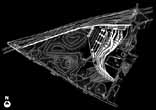 Site Plan. |
||
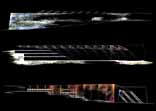 North elevation along Highway 65, Longitudinal Section and South Elevation show the dialectic relationship of the opposing sides of the wall: one side shaped by man, horizontal and monochromatic, simplistic and unadorned, modern and fast, a billboard for the modern age; the other side shaped by the cosmic forces of nature, painted by the motion of the sun, stained and eroded by water and weather, a canvas for the passage of time. 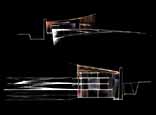 East elevation and cross section, show the compression-release effect of the space and the relationship between the wall, the building and the landscape. |
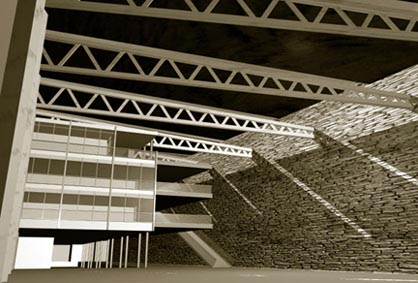 Main view from the museum atrium.  Light and shadow patterns on the inside face of the wall. |
 The gutter system controls the accumulation of rain and snow on the roof and the release of water onto the inside surface of the wall. |
||
| On the inside, a system of stairs runs parallel to the wall in the light well created by the continuous glass strip in the roof, offering a close –but far enough to be untouchable– experience of the limestone canvas. On the outside, the corten steel skin incorporates a moveable teak lattice, which facilitates the spilling of indoor activities onto outdoor landscaped terraces. Weathering of the limestone, corten and teak make the building an intrinsic part of the landscape, an instrument strung by nature and played by the passage of time. The beauty if its music has yet to be discovered. |
||||
| Eric
Arter, Mark Costandi, Don Dispenza, Isabela Castravet Gould. Heritage Welcome Center |
||||
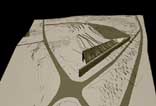 General view. |
International Design Competition, Park City, Kentucky – December, 2000, 2nd Place Winners. architects: Eric Arter Mark Sherif Costandi Donald Dispenza Isabela Castravet Gould The project was presented in a poster format of 10’ x 5’, which combined large-scale hand and computer generated drawings. The entry as well as more details about the competition can be found at the competition website. |
|||
|
>
ARCHITETTURE |
||||
per partecipare alla rubrica architetture laboratorio
|
||||